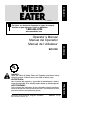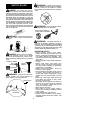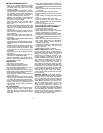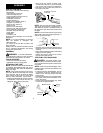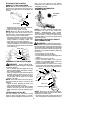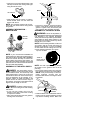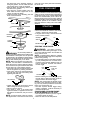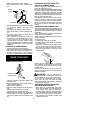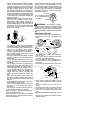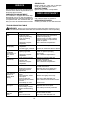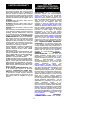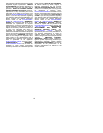
9
S
WHAT CAUSES BLADE THRUST Blade
Thrust can o ccur w hen the spinning blade
contacts an object that it does not cut. This
contact causesthe b ladeto stopforan i nstant
and then suddenly move or “thrust” aw ay
fromtheobject thatwas h it.The “ thrusting”re-
action canbe violent enoughto cause t heop-
eratortobe pr opelledin anydir ection andlose
control of the unit. The uncontrolled unit can
cause serious injury if the blade contacts the
operator or others.
S
WHEN BLADE THRUST OCCURS. Blade
thrust can occur without warning if the
blade snags, stalls, or binds. This is more
likely to occur in areas where it is difficult to
see the material being cut. By using the unit
properly, the occurrence of blade thrust will
be reduced and the operator will be less
likely to lose control.
S
Cutonly grass, weeds,and woodybrush up
to 2inches indiameter withthe brushblade.
Do not let the blade contact material it can-
not cut such as stumps, rocks, fences,
metal, etc., orclusters ofhard, woody brush
having a diameter greater than 2 inches.
S
Keep the blade sharp. A dul l blade is more
likely to snag and thrust.
S
Cut only at full throttle. The blade will have
maximum cutting power and is less likely to
bind or stall.
S
“Feed” the blade deliberately and not too
rapidly. Theblade can thrust away if it isfed
too rapidly.
S
Cut only from your right to your left. Swing-
ing the unit in the same direction as the
blade spins increases the cutting action.
S
Use the shoulder strap and keep a firm grip
on the unit with both hands. A properly ad-
justed shoulder strap will support the
weight of the unit, freeing your arms and
hands to control and guide the cutting mo-
tion.
S
Keep feet com fortably spread apart and
braced f or a possible sudden, rapid thrust o f
unit. Do not overreach. Keep firm footing and
balance.
S
Keep blade below waist level; it will be eas-
ier to maintain control of unit.
S
Donot raise the engine above your waist as
the blade can come dangerously close to
your body.
S
Do not swing unit with such force that you
are in danger of losing your balance.
Bring the engine to cutting speed before en-
tering the material to be cut.
If the blade does not turn when you squeeze
the throttle trigger, m ake sure tube is fully in-
serted into the engine.
Always release the throttle trigger and allow
engine to return to idle speed when not cut-
ting. The blade should not turn while the en-
gine is running at idle. If the bladeturns atidle,
do not us e your unit. Refer to the Carburetor
adjustment section or contact your Autho-
rized Service Dealer.
Cut using the 8 o’clock
to 10 o’clock position of
the blade
10 o’clock
8 o’clock
WARNING:
The operator or others
must nottryto clearaway cutmaterial withthe
engine running or the blade turning to avoid
serious injury. Stop engine and blade before
removing materials wrapped around blade or
tube.
REPLACING THE LINE
S
Press the lock tabs and remove the cover.
S
Remove the lock ring, tap button, and
spool.
Spool
Hub
Lock Ring
Tap
Button
S
Check the indexing teeth on the spool and
hub for wear.
S
Use a clean cloth to wipe the inner/outer
surfaces of the spool and hub.
S
Use onl y .080 inch (2 mm) diameter line.
S
Cut two lengths of line approximately 20
feet (6 m).
S
Insert line into the small hole in the spool.
End of
Line
Arrow on
Spool
S
Wind the line evenly and tightly onto the
spool; wind in direction of arrow found on
spool.
S
Leave 4--6 inches (10--15 cm) of line un-
wound.
S
Insert line into the line exit hole in the hub.
S
Push spool into hub. Press spool down,
then turn it to catch spool tabs under gear
tabs.
S
Re-install t hetap button, lock ring, and cov-
er.
S
Pull the end ofthe line to setspool in the op-
erating position.



